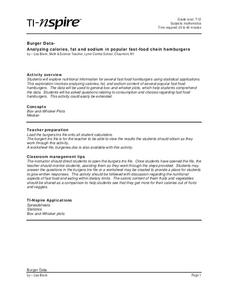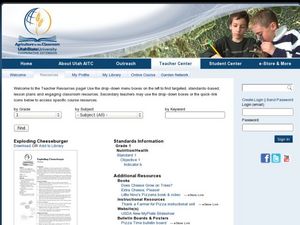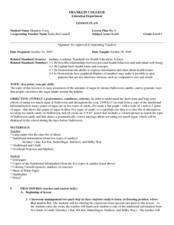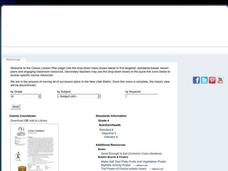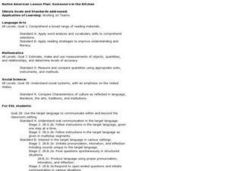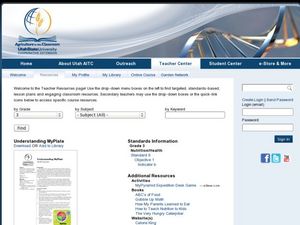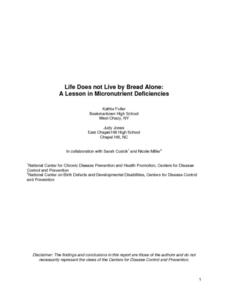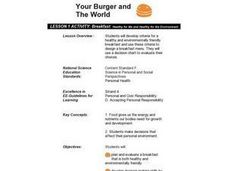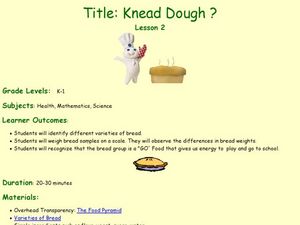Curated OER
Health: Basic Minerals
Students examine minerals as food nutrients and discover their importance as food sources in the diet. Among the learning options are completing worksheets, creating recipes, making billboards, and actually preparing some recipes rich...
Curated OER
Box-and-Whisker Plots
Students explore nutritional information for several fast food hamburgers using statistical applications. In this statistics instructional activity, students analyze calories, fat, and sodium content of various fast food restaurants....
Curated OER
Thanksgiving Feast (Read the Charts)
Learners practice reading charts about foods country of origin. They interpret information and answer questions related to charts. They discover how food production adds to the economy.
Curated OER
WHERE'S THE BEEF?
The student will become visually aware of the different shapes of wholesale cuts of beef.1. Ask a local meat cutter to make a class visit to explain his or her job. 2. Enlarge the steer outline on Student Worksheet B, and place it on a...
Curated OER
Buckets of Bucks for World Hunger
Students participate in a nonprofit organization activity for hunger outreach problems. In this service project lesson plan, students practice counting coins, complete a service project for a hunger outreach, discuss nutrition and...
Curated OER
Exploding Cheeseburgers
Young scholars identify the components of a healthy diet. In this nutrition lesson, students discuss the parts of a cheeseburger and identify the food groups the cheeseburger is a part of. Young scholars discuss how carbohydrates and...
Curated OER
Halloween Candy/ Sugar Content
Fourth graders examine the amount of sugar contained in Halloween candy by looking at nutritional labels from candy bars. They figure out ways to encourage people to reduce the amount of sugar they eat at this holiday. They look at the...
Curated OER
Calorie Countdown
Fourth graders explore human health by identifying calories in food items. In this healthy eating habits lesson, 4th graders view the USDA food pyramid on the Internet and identify the choices they should be making each day. Students...
Curated OER
Little Red Hen
First graders explore biology by identifying plant anatomy in class. In this botany lesson, 1st graders read the book The Little Red Hen and identify the methods used in order to grow successful plants. Students discuss other ways people...
Curated OER
Our Healthy Bodies
Students complete a variety of activities designed to enhance their awareness of their bodies. They examine pictures of themselves, taken at various points in the year and examine and compare their bodies. They enjoy a healthy snack...
Curated OER
Exploding Cheeseburger
Second graders describe the components of a healthy diet. In this nutrition and health lesson, 2nd graders identify the importance in eating a variety of healthy food. Students explain what makes a healthy diet.
Curated OER
Vary Your Veggies and Focus on Fruits
Third graders study a healthy diet. For this healthy diet lesson, 3rd graders investigate the nutritional value of fruits and vegetables. Students compare a healthy diet to their personal diet.
Curated OER
More Than One Grain of Rice
Sixth graders explore cultural habits by viewing food videos in class. In this agriculture lesson, 6th graders identify the importance of rice in the human diet and how different cultures prepare the food. Students view rice harvesting...
Curated OER
Native American Lesson Plan: Someone's in the Kitchen
Students use vocabulary necessary to complete cooking activities and tell others about the food. They discuss similarities and differences between Native American and other nationalities' foods made in their families.
Curated OER
Healthy Diet
Third graders recognize what constitutes a healthy diet and explore if their diet is healthy. In this healthy diet instructional activity, 3rd graders listen read books and explore the food pyramid to find a balanced diet. Students...
Curated OER
Life Does Not Live By Bread Alone
High schoolers investigate the relationship between micronutrients and proper metabolic function. The lesson plan should serve as an introduction to the subject. The subject of the function includes the study of plants, animals, and...
Curated OER
Breakfast: Healthy for Me and Healthy for the Environment
Students develop criteria for a healthy and environmentally friendly breakfast and use these criteria to design a breakfast menu. They use a decision chart to evaluate their choices which is imbedded in this plan.
Curated OER
Energy Balance: The Ins and Outs
Pupils review data from a 24-hour dietary recall to gain an understanding of the information regarding energy intake and macronutrients.
Curated OER
Staying Healthy Year Round
Young scholars will read literature about the seasons and observe and describe the weather in each. The group will compare and contrast the activities of people during different weather conditions showing how they adapt to changes. They...
Curated OER
Claire Damarodas
Fifth graders examine how sugars may be listed as an ingredient in various ways. E.g. Many of the words end in -ose (ex. Sucrose, dextrose, maltose)
Curated OER
Comparing Microscopic Organisms in Fresh and Polluted Water: An Invitation To Inquiry
Young scholars have the opportunity to develop and formulate ideas and explanations through the scientific standard of inquiry. They identify organisms by using an identification key for specific aquatic geographical area.
Curated OER
One Kid Can Make A Difference
Students make a pledge to make three positive choices for 30 days and track their progress. In this positive choices lesson plan, students discuss ways in which they can be healthier, protect the environment, be respectful, and more....
Curated OER
Knead Dough?
Learners make bread and understand that bread gives us energy. For this bread lesson plan, students read the story A Trip to the Market, and learn about the importance of bread. Then they make the bread!
Curated OER
Name That Cheese!
Students explore a variety of cheese. In this cheese lesson, students sample 4 different cheeses produced from cow's milk and recorded their observations about the cheeses prior to identifying them.



